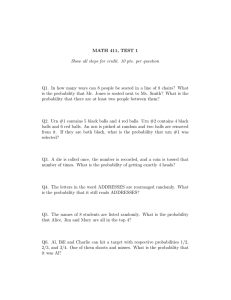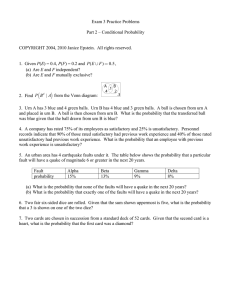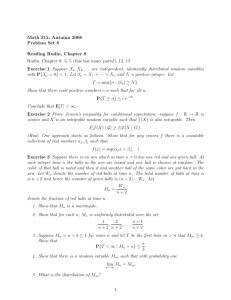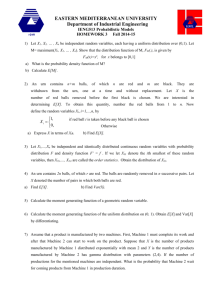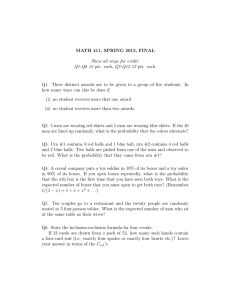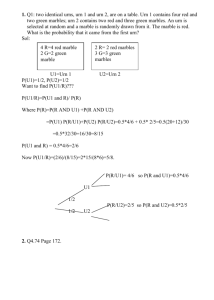ANALYSIS OF A CLASS OF CANNIBAL URNS
advertisement
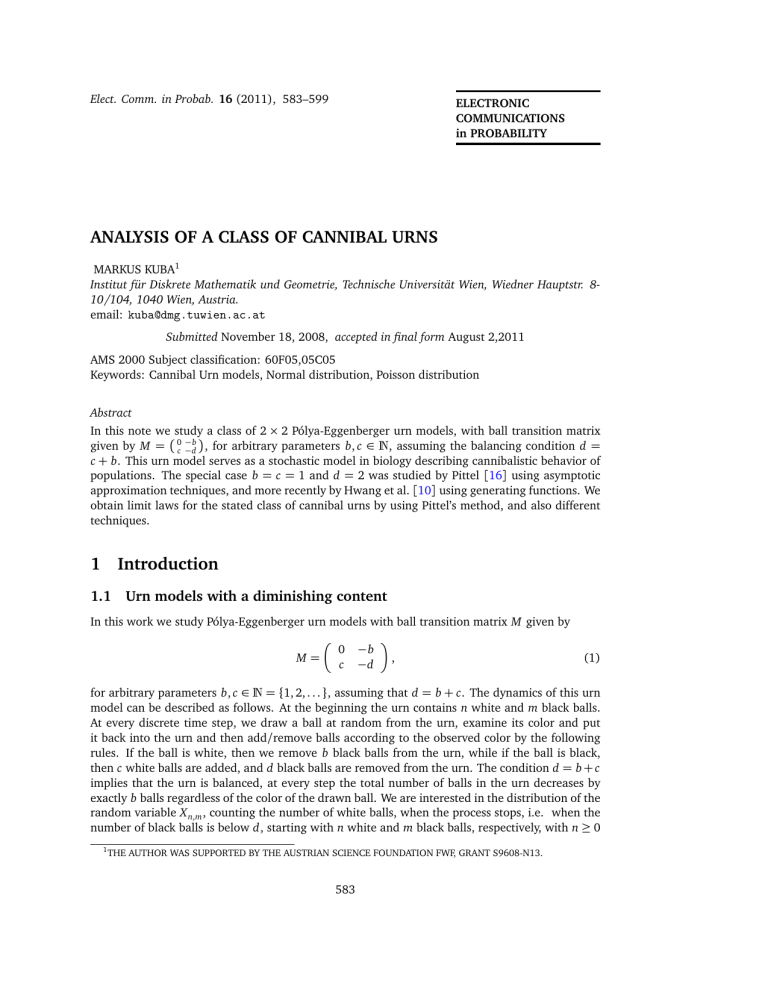
Elect. Comm. in Probab. 16 (2011), 583–599
ELECTRONIC
COMMUNICATIONS
in PROBABILITY
ANALYSIS OF A CLASS OF CANNIBAL URNS
MARKUS KUBA1
Institut für Diskrete Mathematik und Geometrie, Technische Universität Wien, Wiedner Hauptstr. 810/104, 1040 Wien, Austria.
email: kuba@dmg.tuwien.ac.at
Submitted November 18, 2008, accepted in final form August 2,2011
AMS 2000 Subject classification: 60F05,05C05
Keywords: Cannibal Urn models, Normal distribution, Poisson distribution
Abstract
In this note we study a class of 2 × 2 Pólya-Eggenberger urn models, with ball transition matrix
−b
given by M = 0c −d
, for arbitrary parameters b, c ∈ N, assuming the balancing condition d =
c + b. This urn model serves as a stochastic model in biology describing cannibalistic behavior of
populations. The special case b = c = 1 and d = 2 was studied by Pittel [16] using asymptotic
approximation techniques, and more recently by Hwang et al. [10] using generating functions. We
obtain limit laws for the stated class of cannibal urns by using Pittel’s method, and also different
techniques.
1
Introduction
1.1
Urn models with a diminishing content
In this work we study Pólya-Eggenberger urn models with ball transition matrix M given by
M=
0
c
−b
−d
,
(1)
for arbitrary parameters b, c ∈ N = {1, 2, . . . }, assuming that d = b + c. The dynamics of this urn
model can be described as follows. At the beginning the urn contains n white and m black balls.
At every discrete time step, we draw a ball at random from the urn, examine its color and put
it back into the urn and then add/remove balls according to the observed color by the following
rules. If the ball is white, then we remove b black balls from the urn, while if the ball is black,
then c white balls are added, and d black balls are removed from the urn. The condition d = b + c
implies that the urn is balanced, at every step the total number of balls in the urn decreases by
exactly b balls regardless of the color of the drawn ball. We are interested in the distribution of the
random variable X n,m , counting the number of white balls, when the process stops, i.e. when the
number of black balls is below d, starting with n white and m black balls, respectively, with n ≥ 0
1
THE AUTHOR WAS SUPPORTED BY THE AUSTRIAN SCIENCE FOUNDATION FWF, GRANT S9608-N13.
583
584
Electronic Communications in Probability
and m ≥ d. Apparently, the process stops after a finite number of steps, and the number of black
balls is diminishing throughout the evolution of the urn. This urn model is part of a general setting
for Pólya-Eggenberger urns with a diminishing nature, described in detail in [10], see also [9].
For ordinary tenable urn models, where the process of drawing and adding/removing balls can be
repeated ad infinitum we refer the reader to [13, 14, 15], and also for some recent developments
to [2, 7, 5, 6, 11, 12, 20, 21]. A special instance of the class of urns with ball transition matrix
given by (1) is the so-called cannibal urn model, b = c = 1 and d = 2. This urn model has
been introduced by R. F. Greene, see [16], as a stochastic model in biology modelling cannibalistic
behavior in a population. It can be described as follows: a population consists of non-cannibals
and cannibals. At each time instant a non-cannibal is selected as a victim and consumed/removed
and after that a member of the remaining population (non-cannibals and cannibals) is selected at
random. If the selected individual is a cannibal it remains as a cannibal in the population, but if
the selected individual is a non-cannibal it changes its behavior and will become a cannibal. The
question is, when starting with n cannibals and m non-cannibals, what is the number of cannibals
in the population when all non-cannibals are removed? In the general case we assume that b
individuals are consumed at each discrete time step, and that c individuals may become cannibals.
The general model improves upon the original model insofar as it takes into account the effects
of consuming more than one individual at each time step and how it effects the overall number
of cannibals. The original urn model, b = c = 1 and d = 2, has been analyzed by Pittel [16].
His approach is based on asymptotic approximation; more precisely it consists of an asymptotic
approximation of the recurrence of the moment generating function of the random variable of
interest; we refer to the works of Pittel [17, 18, 19] concerning the numerous applications of this
versatile technique. Pittel obtained a normal limit law for X n,m in a certain growth region of n
and m, namely the fraction ρn,m = n/(n + m) has to be bounded away from one, as Nn,m = n + m
tends to infinity. Recently, this model was treated by Hwang et al. [10] using generating functions,
obtaining limit laws for X n,m in every growth region of n and m. Unfortunately, the generating
functions approach of [10] is restricted to the special case b = c = 1 and d = 2. We give a brief
discussion of the difficulties of a generating functions approach in the last section of this work.
We will use the approach of Pittel [16] to obtain asymptotic normality of X n,m in the general
model, assuming that the fraction ρn,m = n/(n + m) is bounded away from one, as Nn,m = n + m
tends to infinity. Furthermore, we can also handle some other cases, where ρn,m → 1 using
different techniques. More precisely, assuming that n → ∞ we prove that the distribution of X n,m
p
p
is asymptotically normal distributed for n m n2/3 , is Poisson distributed for m ∼ n, and
p
degenerates for m n. Unfortunately, we could not determine the limiting distribution of X n,m
in the region n2/3 ≤ m n.
1.2
Urn models and weighted lattice paths
It is well known that the evolution of urn models can be described by weighted lattice paths, see
e.g. Flajolet et al. [5]. Concerning our particular model (1) we have the following description. If
n
the urn contains n white balls and m black balls and we select a white ball (with probability m+n
),
n
then this corresponds to a step from (m, n) to (m − b, n), to which the weight m+n is associated;
m
and if we select a black ball (with probability m+n
), this corresponds to a step from (m, n) to
m
(m − d, n + c) (with weight m+n ). The weight of a path after t successive draws consists of the
product of the weight of every step. By this correspondence, the probability of starting at (m, n)
and ending at ( j, k) is equal to the sum of the weights of all possible paths starting at state (m, n)
and ending at ( j, k). The expressions so obtained for the probability are, although exact, often
Analysis of a class of Cannibal urns
585
less useful for large m or n. Note that, strictly speaking, the description of cannibalistic behavior
described above does not fall directly in the scheme of urn models specified by (1); it is a slight
modification of the urn model, where the weight of a step from (m, n) to (m − b, n) (and thus
n
the probability) is given by n+m−b
and the weight of a step from (m, n) to (m − d, n + c) is given
m−b
n
m
by m−b+n
(instead of weights m+n
and m+n
). However, both types of weights lead to the same
asymptotic behavior, and the proof is readily adapted. Therefore we opted to use the standard
Pólya-Eggenberger urn model weights.
1.3
Goal
Our main goal is to establish the asymptotic normality of X n,m as n → ∞ and n/(n+ m) is bounded
away from one (which excludes the case m = o(n)). Second, we show that assuming that n → ∞
and ρn,m → 1 the distribution of X n,m is still asymptotically normal for intermediate m such that
p
p
n m n2/3 , is Poisson distributed for small m such that m ∼ n, and degenerates for very
p
small m such that m = o( n). The proof technique of the asymptotic normality applied here in the
case of Nn,m → ∞, with ρn,m = n/(n + m) bounded away from one, follows closely the asymptotic
approximation proof method of Pittel of the original problem [16].
1.4
Notations and Overview
L
We use the notations N = {1, 2, . . . } and N0 = {0, 1, . . . }, and denote with −
→ the convergence
in distribution. We use the abbreviations Nn,m = n + m and ρn,m = n/Nn,m = n/(n + m), and the
notations m n, standing for m = o(n), n ∼ m standing for m/n → 1, as n tends to infinity. For
sequences (n, m) = (ni , mi )i∈N , by the formulation "ρm,n is bounded away from one" we mean that
for any " > 0 the inequality ni /(ni + mi ) > 1 − ε holds for only finitely many i. Throughout this
p
work we mostly drop the subscript i for the sake of simplicity. The notation n m n2/3 for
n → ∞ means that we consider double sequences (n, m) = (ni , mi )i∈N with ni → ∞, such that
p
both conditions m = o(n2/3 ) and n = o(m) are satisfied; this implies that m tends to infinity as
n → ∞. In the next section we state the limiting distributions of X n,m , specified according to the
growth of n and m. In Section 3 we establish the part concerning the normal limit of X n,m for ρn,m
bounded away from one. Section 4 contains the derivations of the limiting distribution results
for intermediate and small m. The last section is devoted to a brief discussion of an alternative
approach based on generating functions.
2
Results
In the following we will state the limiting distribution of the random variable X n,m , counting the
number of white balls when the number of black balls is below d, with respect to the general
Cannibal urn model with ball transition matrix (1), starting with n white and m black balls.
Theorem 1. The limiting distribution of X n,m , assuming that n → ∞, is specified according to the
growth of m and n.
1. For m at least of order n, i.e. ρn,m = n/(n + m) bounded away from one
∗
X n,m
=
X n,m − Nn,m φ(ρn,m ) L
−
→ N (0, 1),
p
Nn,m ψ(ρn,m )
(Nn,m = n + m);
586
Electronic Communications in Probability
here φ(t) and ψ(t) are given by
for b = c,
b
(bt+c(1−t)) b−c
, for b 6= c,
b
t−1
e
φ(t) =
,
and
c(t 2 − 3t + 3)e2t−2 − ce t−1 , for b = c,
2b
b
2 2
2
2
2
−c b (bt+c(1−t)) b−c
(bt+c(1−t)) b−c
bc
ψ(t) = bc (bc−2c )t −(b −4c )t−2c
+
, for b 6= c, 2c.
(b−2c)((b−c)t+c)2
b
b−2c
b
c 81 t 2 − 12 t + 12 log(t + 1) + 38 − 12 log(2) (t + 1)2 , for b = 2c.
2. For an intermediate m such that
p
∗
X n,m
n m n2/3 ,
X n,m − n −
=
Æ 2 2
cm2
2bn L
−
→ N (0, 1),
c m
2bn
1
∗
3. For small m such that m ∼ λn 2 , with λ ∈ R+ , the random variable X n,m
= (X n,m − n)/c is
2
asymptotically Poisson distributed with parameter λ /(2b),
L
∗
X n,m
−
→ X,
4. For very small m such that m p
L
X = Po(
λ2
2b
).
∗
n the distribution of X n,m
= (X n,m − n) degenerates,
∗
P{X n,m
= 0} → 1.
The result stated in the first case of Theorem 1 can be extended as follows.
Theorem 2. For Nn,m = n + m → ∞ with ρn,m = n/(n + m) being bounded away from one
∗
X n,m
=
X n,m − Nn,m φ(ρn,m )) L
−
→ N (0, 1),
p
Nn,m ψ(ρn,m )
with φ(t) and ψ(t) as given in Theorem 1.
This includes in particular the cases n → ∞, with m at least of order n, and the cases of fixed
n ∈ N and m tending to infinity.
Remark 1. We did not manage to obtain results for the missing region n2/3 ≤ m n. We
expect that the centered and normalized random variable X n,m remains normal distributed in the
limit n → ∞, by analogy with the results of [10], where the limiting distributions of the original
problem (b = c = 1, d = 2) were obtained using generating functions.
Remark 2. As observed by Pittel in the special case b = c = 1 and d = 2, we anticipate that
E(X n,m ) is for large n compared to m close to n and the variance is close to zero. Indeed we have
φ(1) = 1 and ψ(1) = 0. The case b = c correspondsto the original cannibal urn problem, since
the ball transition matrix M reduces to M = b · 01 −1
−2 .
Analysis of a class of Cannibal urns
587
Remark 3. The results for the region m n2/3 basically say that (X n,m − n)/c is asymptotically
2
m
Poisson distributed with parameter 2bn
. Our results in the region m n2/3 can be extended to
0 −b
the urn model with ball transition matrix M = −c
−d , with c ∈ N, d ∈ N0 = {0, 1, . . . } and
b = c + d. As for the cannibal urn model one obtains a degenerate distribution for n − X n,m when
1
p
m = o( n), a Poisson limiting distribution for (n − X n,m )/c in the range m ∼ λn 2 , and a standard
p
normal limiting distribution for n m n2/3 .
3
Asymptotic normality by asymptotic approximation
In the following we will prove Theorem 2, which includes Theorem 1 case (1), using Pittel’s
approach [16] to the original problem b = c = 1, d = 2.
3.1
Recurrence relations
By definition of Pólya-Eggenberger urn models the random variable X n,m satisfies the following
recursive distributional equation, which is obtained by considering the urn after the first draw
when starting with n white and m black balls.
L
X n,m =
0
In,m X n,m−b + (1 − In,m )X n+c,m−b
,
n,
for n ≥ 0, m ≥ d,
(2)
for n ≥ 0, m < d,
where In,m denotes the indicator variable of the event that a white ball is drawn,
P{In,m = 1} =
n
n+m
,
P{In,m = 0} =
m
n+m
.
0
with In,m being independent of (X n,m )n,m≥0 and (X n,m
)n,m≥0 , which are independent copies of each
other.
By (2), the Laplace transforms g n,m (z) = E(ezX n,m ) of X n,m satisfy a similar recurrence relation,
given as follows.
n
m
· g n,m−b (z) +
· g n+c,m−d (z), for n ≥ 0, m ≥ d,
(n + m)
g n,m (z) = (n + m)
(3)
nz
e , for n ≥ 0, m < d.
When b = c one may start with b · n white and b · m black balls, reducing the problem essentially to the original cannibal urn model. In order to prove asymptotic normality of X n,m (suitably centered and normalized) using asymptotic approximation techniques, see [16, 17, 18, 19],
we introduce an auxiliary sequence of random variables (Yn,m )n,m≥0 , whose Laplace transforms
hn,m (z) = E(ezYn,m ) are given by
z2
hn,m (z) = exp zNn,m φ(ρn,m ) + Nn,m ψ(ρn,m ) ,
2
ρn,m =
n
n+m
,
(4)
with functions φ(t) and ψ(t) as given in Theorem 1. Clearly, the random variables Yn,m are normal distributed with mean Nn,m φ(ρn,m ) and variance Nn,m ψ(ρn,m ). We will prove that hn,m (z) =
588
Electronic Communications in Probability
E(ezYn,m ) almost satisfies a recurrence (3), see Lemma 1. The reason for this, as we shall see, is
that φ(t), ψ(t) is the solution of a system of differential equations (8) and (9). We will see that
for Nn,m = n + m → ∞ such that ρn,m is bounded away from 1, ψ(ρn,m ) is bounded away from
0, see Lemma 2, and that the Laplace transforms of X n,m and Yn,m are close enough to imply, see
Lemma 5, that X n,m is asymptotically normal distributed with mean Nn,m φ(ρn,m ) and variance
Nn,m ψ(ρn,m ). Note that the assumption Nn,m = n + m → ∞ such that ρn,m is bounded away from
one includes cases n → ∞ and m at least of order n, but also other cases, i.e. arbitrary but fixed
n ∈ N and m → ∞.
3.2
An estimate for the Laplace transforms
1/2
Lemma 1. For fixed u > 0 and z ∈ R such that Nn,m
|z| ≤ u for Nn,m → ∞ the Laplace transforms
zYn,m
hn,m (z) = E(e
), as defined in (4), according to the φ(t) and ψ(t) given in Theorem 1, satisfy
k
(k + l)
· hk,l−b (z) +
l
(k + l)
· hk+c,l−d (z) = hk,l (z) · e
|z|
O(N
k,l
)
,
uniformly over d + 1 ≤ l ≤ Nn,m and 0 ≤ k ≤ Nn,m − l.
Remark 4. The functions φ(t) and ψ(t), appearing in the definition (4) of hn,m (z) = E(ezYn,m ),
are actually a priori unknown; they are determined via the differential equations (8) and (9) such
that the statement of Lemma 1 is true. However, in order to present the proof of the lemma above
in a clear manner it is beneficial to reverse the order of argumentation, making the proof more
1/2
transparent. The condition Nn,m
|z| ≤ u is natural with respect to the fact that we are interested,
1/2
1/2
see Lemma 5, in the normalized quantities hn,m (z/Nn,m
) and g n,m (z/Nn,m
).
Proof. In order to obtain the stated asymptotic expansions of
note first that
ρk,l−b =
ρk+c,l−d =
k
k+l−b
k+c
k+c+l−d
=
=
k
Nk,l − b
k
Nk,l − b
=
+
ρk,l
1−
b
Nk,l
c
Nk,l − b
k
h
(z)
(k+l) k,l−b
= ρk,l +
= ρk,l +
and
l
h
(z)
(k+l) k+c,l−d
bρk,l
Nk,l (1 −
b
Nk,l
)
,
(5)
bρk,l + c
Nk,l (1 −
b
Nk,l
we
)
.
We apply Taylor’s theorem to the smooth functions φ(t) and ψ(t), as defined in Theorem 1,
and obtain first order approximations of φ(ρk,l−b ), ψ(ρk,l−b ) and φ(ρk+c,l−d ), ψ(ρk+c,l−d ) at ρk,l
valid for all k and l. The error term in the first order approximation is uniformly bounded for
2
all k and l, i.e. uniform upper bounds are given by (b + c)2 · max t∈[0,1] {|φ 00 (t)|} · (b + 1)2 /Nk,l
2
00
2
2
and (b + c) · max t∈[0,1] {|ψ (t)|} · (b + 1) /Nk,l , respectively, due to the fact that 0 ≤ ρk,l ≤ 1,
Nk,l = k + l ≥ d + 1 > b + 1 and that φ 00 (t) and ψ00 (t) are continuous functions on [0, 1]. By
Analysis of a class of Cannibal urns
589
definition of hn,m (z), (4), we readily obtain
z2
hk,l−b (z) = hk,l (z) · exp − z bφ(ρk,l ) + z bρk,l φ 0 (ρk,l ) − bψ(ρk,l )
2
z2
|z|
× exp
bρk,l ψ0 (ρk,l ) + O (
) ,
2
Nk,l
hk+c,l−d (z) = hk,l (z) · exp z(c − d)φ(ρk,l ) + z((d − c)ρk,l + c)φ 0 (ρk,l ) ×
× exp
z2
2
(c − d)ψ(ρk,l ) +
z2
2
((d − c)ρk,l + c)ψ0 (ρk,l ) + O (
(6)
|z| ) ,
Nk,l
where the error term is uniform in both k and l due to our previous considerations. Subsequently,
we use the auxiliary quantities
Ak,l = b ρk,l φ 0 (ρk,l ) − φ(ρk,l ) ,
Bk,l = (c − d)φ(ρk,l ) + ((d − c)ρk−l + c)φ 0 (ρk,l ) ,
Ck,l = b ρk,l ψ0 (ρk,l − ψ(ρk,l ) ,
Dk,l = (c − d)ψ(ρk,l ) + ((d − c)ρk,l + c)ψ0 (ρk,l , (7)
in order to write (6) as
z2
|z| hk,l−b (z) = hk,l (z) · exp zAk,l + Ck,l + O (
) ,
2
Nk,l
z2
|z| ) .
hk+c,l−d (z) = hk,l (z) · exp zBk,l + Dk,l + O (
2
Nk,l
We obtain by expansion at z = 0
k
k+l
·
=
hk,l−b (z)
hk,l (z)
+
l
k+l
·
hk+c,l−d (z)
hk,l (z)
=
z2
|z| l
z2
|z| exp zAk,l + Ck,l + O (
) +
exp zBk,l + Dk,l + O (
)
k+l
2
Nk,l
k+l
2
Nk,l
k
= 1 + z(ρk,l Ak,l + (1 − ρk,l )Bk,l ) +
z2
(ρk,l (A2k,l + Ck,l )
2!
|z|
2
+ (1 − ρk,l )(Bk,l
+ Dk,l )) + O (
).
Nk,l
The error term, obtained by third order Taylor approximation of exp(z 2 ) and second order approximation of exp(z), is again uniform in both k and l. Note again that by definition 0 ≤ ρk,l ≤ 1, for
all k and l; moreover, we get uniform upper bounds for the quantities Ak,l , Bk,l , Ck,l and Dk,l using
upper bounds for the absolute values of the functions φ(t), ψ(t) and their derivatives on the unit
|z|
interval. Furthermore, we use the fact that |z|3 = O ( N ). The coefficient of z is zero,
k,l
ρk,l Ak,l + (1 − ρk,l )Bk,l = 0,
(8)
since it is readily checked that the function φ(t), as given in Theorem 1, satisfies the differential
equation stated below on the interval [0, 1] with initial condition φ(1) = 1.
t b tφ 0 (t) − φ(t) + (1 − t) (c − d)φ(t) + (t(d − c) + c)φ 0 (t) = 0.
590
Electronic Communications in Probability
Moreover, the coefficient of z 2 also equals zero,
2
ρk,l (A2k,l + Ck,l ) + (1 − ρk,l )(Bk,l
+ Dk,l ) = 0,
(9)
since the function ψ(t), as given in Theorem 1, satisfies the differential equation stated below on
the interval [0, 1] with initial condition ψ(1) = 0
ψ0 (t)(t 2 (b + c − d) + t(d − 2c) + c) − ψ(t)(t(b + c − d) + d − c) = F (t),
with inhomogeneous part F (t) given by
F (t) = (t − 1)(φ 0 (t)(t(d − c) + c) + (c − d)φ(t))2 ) − b2 t(tφ 0 (t) − φ(t))2 .
Consequently, we get the result
k
k+l
·
hk,l−b (z)
hk,l (z)
+
l
k+l
·
hk+c,l−d (z)
hk,l (z)
=1+O(
|z|
Nk,l
) = exp(O (
|z|
Nk,l
)).
(10)
∗
Next we study the roots of the function ψ(t) in order to ensure that the random variable X n,m
,
X
∗
p
defined by X n,m
= n,m
−Nn,m φ(ρn,m )
Nn,m ψ(ρn,m )
, is well defined for all n, m ≥ 1.
Lemma 2. The function ψ(t), as given in Theorem 1, has no roots in the half-open interval [0, 1).
Furthermore, ψ(t) > 0 for t ∈ [0, 1) and ψ(1) = 0.
Proof. We first consider the case b 6= c, 2c. The function ψ(t) is given by
ψ(t) = bc
(bc − 2c 2 )t 2 − (b2 − 4c 2 )t − 2c 2 − c b (bt + c(1 − t)) 2b
(b − 2c)((b − c)t +
b−c
c)2
b
+
bc
(bt + c(1 − t)) b − 2c
b
b
b−c
It has a roots at t = 1 and another root at t = c/(c − b). In the case c > b > 0 it follows that
c/(c − b) > 1. If the converse is true b > c > 0 then c/(c − b) < 0. Altogether, for b 6= c this implies
that c/(c−b) ∈
/ [0, 1]. Moreover, it can be shown by tedious but routine calculations that ψ(0) > 0,
and further ψ(t) > 0 for t ∈ (0, 1). Next we consider the case b = c with ψ(t) = c exp(t − 1)ψ1 (t)
and ψ1 (t) = (t 2 − 3t + 3) exp(t − 1) − 1. The function ψ(t) is zero exactly when ψ1 (t) is zero.
We note that ψ1 (0) = 3e−1 − 1 > 0 and that ψ1 (1) = 0. Moreover, ψ1 (t) is strictly decreasing
on the interval (0, 1). By continuity of ψ1 (t) the function ψ1 (t) has no root in [0, 1). Therefore,
the function ψ(t) has no root in [0, 1). Similar arguments can be used for the remaining case
b = 2c.
Note that many computer algebra systems deliver a wrong solution for ψ(t). We remark the
special solutions for the cases b = c, and b = 2c, can be obtained from the general solution ψ(t)
for b 6= c, 2c by taking the appropriate limits.
An immediate application of Lemma 2 is the following result concerning the value ψ(ρn,m ).
Lemma 3. For Nn,m = n + m → ∞, such that ρn,m = n/(n + m) is bounded away from 1, the value
ψ(ρn,m ) is bounded away from 0, with function ψ(t) as given in Theorem 1.
.
Analysis of a class of Cannibal urns
3.3
591
Relating the Laplace transforms
We have proven in Lemma 1 that the Laplace transforms hn,m (z), as defined in (4), of the normal
distributed random variables Yn,m almost satisfy the recurrence relation 3 with respect to an error
term as given in Lemma (1). The next result relates the Laplace transforms g n,m (z) = E(ezX n,m )
and hn,m = E(ezYn,m ) of the random variables X n,m and Yn,m .
1/2
Lemma 4. For fixed u > 0 and z ∈ R such that Nn,m
|z| ≤ u, we have
i
X
g k,l (z) = hk,l (z) exp O |z|
r=1
1
N0 + r b
,
uniformly over d ≤ l ≤ Nn,m and 0 ≤ k ≤ Nn,m − l, where k + l = N0 + i b, with 1 ≤ N0 < d.
Proof by induction. We proceed exactly along the lines of Pittel [16] by using induction with respect to the total number of balls Nn,m contained in the urn. By definition of φ(t) and ψ(t), see
Theorem 1, we have g n,0 (z) = hn,0 (z) for all n ∈ N. There exists a constant λ > 0 such that for all
Nn,m < d
g n,m (z) = exp(nz) ≤ hn,m (z) exp λ|z| .
The starting point for the induction is N0 , with 1 ≤ N0 < d. We assume now that the constant
λ > 0 is large enough such that
g k,l (z) ≤ hk,l (z) exp λ|z|
and also
k
k+l
hk,l−b (z) +
l
k+l
i
X
1
r=1
N0 + r b
hk+c,l−d (z) ≤ hk,l (z) · e
|z|
λ( N
k,l
)
,
for all k ∈ N and l ∈ N with k + l = N0 + i b, with 0 ≤ i < j and j = j(Nn,m ) with respect to
Nn,m = j b + N0 . Then we have for k + l = Nn,m = j b + N0
g k,l (z) =
≤
k
k+l
g k,l−b (z) +
k
k+l
l
k+l
hk,l−b (z) +
≤ hk,l (z) exp λ|z|
g k+c,l−d (z)
l
k+l
j−1
X
hk+c,l−d (z) exp λ|z|
r=1
j−1
X
1
r=1
N0 + r b
+
λ|z| k+l
1
N0 + r b
= hk,l (z) exp λ|z|
)
j
X
1
r=1
N0 + r b
.
The other direction is proven as follows. There exists a constant λ0 > 0 such that for all k + l < d
hk,l (z) ≤ g k,l (z) exp λ0 |z| .
Choosing the same N0 as before, with 1 ≤ N0 < d, we assume now that the constant λ0 > 0 is
large enough such that
i
X
1
hk,l (z) ≤ g k,l (z) exp λ0 |z|
N + rb
r=1 0
592
Electronic Communications in Probability
and also according to Lemma 1
k
λ0 |z| l
hk,l−b (z) +
hk+c,l−d (z) · exp
≥ hk,l (z).
k+l
k+l
Nk,l
for all k ∈ N and l ∈ N with k + l = N0 + i b, with 0 ≤ i < j. Then we have for k + l = Nn,m
hk,l (z) ≤
≤
k
k+l
hk,l−b (z) +
k
k+l
g k,l−b (z) +
= g k,l (z) exp λ|z|
λ0 |z| hk+c,l−d (z) · exp
k+l
Nk,l
l
j
X
g k+c,l−d (z) exp λ|z|
l
k+l
r=1
j
X
1
r=1
N0 + r b
1
N0 + r b
.
We can write
j
X
1
j
r=1
N0 + r b
=
1X
N0
r=1 b
b
1
=
+r
N0
N0 1
Ψ( j + 1 +
) − Ψ(1 +
) ,
b
b
b
where Ψ(t) = ddt log Γ(t) denotes the Digamma function, see [1]. Using the asymptotic expansion
of the Digamma function Ψ(n + 1) = log n + 1/n + O (1/n2 ) and setting Nn,m = N0 + j b we get
j
X
1
r=1
N0 + r b
∼
1
b
log Nn,m ,
Lemma 5. Assume that Nn,m = n + m tends to infinity, with ρn,m bounded away from one. Then, for
X
∗
p
every fixed z ∈ R the Laplace transform of X n,m
= n,m
∗
E(ezX n,m ) = exp(
z2
2
−Nn,m φ(ρn,m )
Nn,m ψ(ρn,m )
)+O(
is given by
log Nn,m
),
p
ψ(ρn,m ) Nn,m
Proof. By Lemma 3 ψ(ρn,m ) is bounded away from zero, and consequently the value of the exp
∗
and g n,m (z), see (3), we have
pression 1/ ψ(ρn,m ) is bounded. By definition of X n,m
∗
E(ezX n,m ) = g n,m p
p
φ(ρn,m ) exp − z Nn,m p
.
Nn,m ψ(ρn,m )
ψ(ρn,m )
z
Using Lemma 4, the expansion of the Digamma function, and the definition of the hn,m (z), see (4),
we obtain
p
φ(ρn,m ) z
∗
E(exp(zX n,m
)) = hn,m p
exp − z Nn,m p
Nn,m ψ(ρn,m )
ψ(ρn,m )
log Nn,m
× exp O ( p
)
Nn,m ψ(ρn,m )
z2 z2 log Nn,m
log Nn,m
= exp
exp O ( p
) = exp
+ O (p
).
2
2
Nn,m ψ(ρn,m )
Nn,m ψ(ρn,m )
Analysis of a class of Cannibal urns
593
∗
Corollary 1. The random variable X n,m
is asymptotically normal distributed.
Proof. By Curtiss’ theorem [4] the pointwise convergence of the sequence of moment generating functions implies the weak convergence of the corresponding sequence of random variables.
∗
Hence, by Lemma 5 we obtain the asymptotic normality of the random variable X n,m
.
4
Proofs for the other regions
In order to prove the results in the cases two to four of Theorem 1, with n tending to infinity
and ρn,m → 1, we proceed differently by studying directly the probabilities P{X n,m = k}. The
distributional equation (2) implies the following recurrence relation for the probabilities P{X n,m =
k}.
n
m
· P{X n,m−b = k} +
· P{X n+c,m−d = k}, n ≥ 0, m ≥ d,
(n + m)
P{X n,m = k} = (n + m)
(11)
δn,k , for n ≥ 0, m < d.
where δn,k denotes the Kronecker delta function.
4.1
The degenerate case
We consider the fourth case of Theorem 1. In order to obtain a closed formula for P{X n,m = n}
we use the recursive description of the probabilities P{X n,m = k} as stated in (11). The number of
white balls is non-decreasing, in other words P{X n+`·c,m = n} = 0, for all ` ≥ 1 and m ≥ 0. Hence,
we get for k = n the simple recurrence relation
P{X n,m = n} =
n
(n + m)
· P{X n,m−b = n},
m ≥ d, n ≥ 0.
This recurrence relation is readily solved and we get the following explicit expression for P{X n,m =
n}, valid for m ≥ 0 and n ≥ 0.
b m−d
c
b
P{X n,m = n} =
Y `=0
n
n + m − `b
=
nb
m−d
b
bb
c+1
m−d
b
Γ( n+m
− b m−d
c)
b
b
c+1
+ 1)
Γ( n+m
b
.
In order to obtain an asymptotic expansion of P{X n,m = n} = P{X n,m − n = 0} for n → ∞ and
p
m n we will use Stirling’s formula for the Gamma function
x x p2π 1
1
1 Γ(x) =
1+
+
+
O
(
) ,
p
e
12x
288x 2
x3
x
(12)
and the following expansion of (1 + nx )n with respect to n tending to infinity and x = x(n),
x n2/3 ,
x n
x x2
x3 1+
= exp n log(1 + ) = exp x −
+O( 2) .
(13)
n
n
2n
n
594
Electronic Communications in Probability
p
Application of (12) and (13) gives for m = o( n) the asymptotic expansions
Γ(
n+m
b
−b
m−d
b
c) ∼
n
b
n+m
−b m−d
b
b
n
eb
cp
2π
pn
Γ(
,
n+m
b
b
+ 1) ∼
n+m
+1
b
n
b
n
eb
p
2π
pn
.
b
By combining the stated asymptotic expansion we obtain the result
P{X n,m = n} =
4.2
nb
m−d
b
bb
c+1
m−d
b
Γ( n+m
− b m−d
c)
b
b
c+1
+ 1)
Γ( n+m
b
∼ 1,
or equivalently
P{X n,m − n = 0} ∼ 1.
The Poisson case
We study the third case of Theorem 1 and derive a closed formula for P{X n,m = n + ck}, for
arbitrary k ≥ 0, from the recurrence relation 11 using combinatorial arguments with respect to
the weighted lattice path description of the evolution of the urn model, see Subsection 1.2. This
allows to determine exactly the numerator r(n, m, k) and the denominator s(n, n, k) of P{X n,m =
n + ck} = r(n, m, k)/s(n, n, k). The probability P{X n,m = n + ck} corresponds to all possible
evolutions of the urn starting with n white balls and m black balls and ending with n + c · k white
balls. The increase of c · k white balls corresponds to exactly k draws were a black ball is chosen,
in all other draws a white ball is chosen. In each of these k draws we add c white balls and remove
d = b + c black balls. First we have to determine the number of draws until the evolution of the
urn stops with respect to the initial configuration of n white and m black balls. Since the evolution
of the urn continues until m < d and we assume that there are exactly k draws were a black ball
m−(k+1)d
is chosen and consequently d black balls removed, we have b
c + 1 draws were a white
b
m−(k+1)d
ball is chosen. Consequently, there are a total of b
c + 1 + k draws until the evolution of
b
the urn stops. Due to the fact that the urn is balanced, −b = c − d, the denominator s(n, n, k) of
P{X n,m = n + ck} is given by the closed formula
b
s(n, n, k) =
m−(k+1)d
b
Y c+k
`=0
(n + m − l b) =
bb
m−(k+1)d
b
c+1+k
Γ( n+m
−b
b
Γ( n+m
+ 1)
b
m−(k+1)d
c−
b
.
(14)
k)
The k events that a black ball is drawn, which leads to an addition of c white balls and the removal
m−(k+1)d
c+1+k draws: the first draw of a black ball can happen
of d black balls, occur during the b
b
m−(k+1)d
at stage `1 + 1 of the evolution of the urn, with 0 ≤ `1 ≤ b
c. The upper bound is due to
b
the fact that we still have to draw k − 1 black balls until the evolution of the urn stops, i.e. m < d.
The second draw of a black ball can happen at stage `2 + `1 + 2 of the evolution of the urn, with
0 ≤ `2 ≤ b m−kd
c − `1 . Similar arguments provide the possible ranges for all of the k draws of
b
black balls. Each of such event of drawing a black ball happens with probability proportional to
the number of blacks balls in the urn. Hence, the numerator r(n, n, k) of P{X n,m = n + ck} is given
Analysis of a class of Cannibal urns
595
by
b
r(n, m, k) =
m−(k+1)d
b
c−`1
b m−kd
b
c
X
X
(m − b`1 )
`1 =0
(m − d − b`1 − b`2 ) . . .
`2 =0
c−(`1 +···+`k−1 )
b m−d
b
X
(15)
(m − (k − 1)d − b(`1 + · · · + `k−1 ))
`k =0
× nl1 (n + c)l2 . . . (n + (k − 1)c)lk (n + kc)b
m−(k+1)d
b
c+1−(`1 +···+`k−1 +`k )
.
We observe that r(n, m, k) is for arbitrary but fixed k ≥ 0 asymptotically given by
b
r(n, m, k) ∼ n
b
m−(k+1)d
b
m−(k+1)d
b
X
c+1
b m−kd
c−`1
b
c
(m − b`1 )
X
(m − d − b`1 − b`2 ) . . .
`2 =0
`1 =0
b m−d
c−(`1 +···+`k−1 )
b
X
(m − (k − 1)d − b(`1 + · · · + `k−1 )).
`k =0
We will use Euler’s summation formula, see i.e. [8], to obtain the leading term with respect to m
in the expression above. It is more instructive to slightly extend the “sum”-notation, and rewrite
the expression for the numerator in the following way
l1 − db
m
r(n, m, k) ∼ n
m−(k+1)d
b
b
b
X
c+1 k
b
`1 = mb −b
`1
m−(k+1)d
b
l k−1 −
X
l2 · · ·
`2 = mb −b m−kd
c
b
c
d(k−1)
Xb
`k .
(16)
`k = mb −b m−d
c
b
By application of Euler’s summation formula we obtain the leading term
b
r(n, m, k) ∼ n
= nb
m−(k+1)d
b
m−(k+1)d
b
c+1 k
Z
m
b
Z
m
Z
...
b
c+1
t1
0
0
2k
b k 2k k!
t k−1
t1 t2 . . . t k d t k . . . d t1 =
0
m2k
b2k 2k k!
nb
m−(k+1)d
b
c+1 k
b
.
p
By our assumptions n → ∞ and m ∼ λ n, we get further
r(n, m, k) ∼
λ2k
b k 2k k!
nb
m−(k+1)d
b
c+1
.
An asymptotic analysis of the denominator using Stirling’s formula (12) and (13) finally gives the
desired result
λ2k
λ2
P{X n,m = n + ck} ∼ k k e− 2b , k ≥ 0.
b 2 k!
4.3
The intermediate case
p
Our results for the region m ∼ n show that (X n,m − n)/c is asymptotically Poisson distributed
p
with parameter Λ = Λ(n, m) = m2 /(2bn). Our aim is to extend this result to the region n 596
Electronic Communications in Probability
m n2/3 . It seems difficult to extend this result beyond m ∼ n2/3 , due to the expansion of the
denominator s(n, m, k) with respect to 13. Moreover, the results of [10] suggest that for m = o(n)
the expectation satisfies the expansion
E(X n,m ) = n +
cm2
2bn
+O
m3 .
n2
We will use the following well known result concerning the asymptotic normality of Poisson distributed random variables [3].
Lemma 6. Assume that the sequence of random variables (X t ) t∈N is Poisson distributed with parameter Λ t , where Λ t → ∞ as t tends to infinity. Then X t , suitably centralized and normalized, is
asymptotically normal distributed,
p
P{X t ≤ Λ t + x · Λ t } → Φ(x), for x ∈ R,
p1
2π
where Φ(x) =
u2
Rx
−∞
e− 2 du denotes the standard normal distribution function.
By Lemma 6 and we have to show that (X n,m − n)/c is asymptotically Poisson distributed with
parameter Λ = Λ(n, m) = m2 /(2bn),
P{
X n,m − n
c
k
X
Λ` ≤ k} = e−Λ
(1 + o(1)),
`!
`=0
p
for k = Λ+ x · Λ, with arbitrary but fixed x ∈ R. Then, an application of Lemma 6 proves the normal limit. Since we already know that the probabilities P{X n,m − n ≤ ck} = r(n, m, k)/s(n, m, k),
with r(n, m, k) and s(n, m, k) given by (15) and (14), respectively, the remaining obstacle is to refine our previous results and to obtain a uniform bound on the error term in the expansion of p
the
numerator r(n, m, k) (15) and the denominator s(n, m, k) (14), with respect to 1 ≤ k ≤ Λ + x · Λ
and Λ = Λ(n, m) = m2 /(2bn). First we observe that
nb
m−(k+1)d
b
c+1
≤ n`1 (n + c)`2 . . . (n + (k − 1)c)`k (n + kc)b
≤ (n + kc)b
m−(k+1)d
b
m−(k+1)d
b
c+1−
Pk
h=1 `h
c+1
p
for all choices of `1 , . . . , `k , uniformly for k ≤ Λ + x · Λ, and arbitrary but fixed x ∈ R. We obtain
the uniform asymptotic expansion
n`1 (n + c)`2 . . . (n + (k − 1)c)`k (n + kc)b
m−(k+1)d
b
c+1−
Pk
h=1 `h
= nb
m−(k+1)d
b
c+1
1+O(
m3 ) .
n2
By application of Euler’s formula we get
m
b
k
`1 − db
b
X
`1 = mb −b
`1
m−(k+1)d
b
c
X
`2 = mb −b m−kd
c
b
`k−1 −
`2 · · ·
d(k−1)
Xb
`k = mb −b m−d
c
b
`k =
m2k
b k 2k k!
(1 + O (
m3
n2
)),
p
uniformly for k ≤ Λ + x · Λ. Consequently, we get the required uniform expansion of the numerator r(n, m, k) (15). Using similar uniform expansion of the denominator s(n, m, k), as given in
(14), and combining the two estimates, we finally obtain
k
X
Λ` m3
P{X n,m − n ≤ c · k} = e−Λ
(1 + O ( 2 )),
`!
n
`=0
Analysis of a class of Cannibal urns
597
which implies that (X n,m −n)/c is asymptotically Poisson distributed with parameter Λ = Λ(n, m) =
p
m2 /(2bn), where Λ → ∞ as n tends to infinity, with n m n2/3 . Lemma 6 then gives the
desired result
r
X n,m − n
m2
m2
m3
P{
≤
+x·
} = Φ(x)(1 + o(1))(1 + O ( 2 )) ∼ Φ(x).
c
2bn
2bn
n
5
Exact solvability - An outlook
As mentioned in the introduction Hwang et al. [10] obtained simple expressions for the exact
probability distribution of X n,m in the case of the original cannibal urn model b = c = 1 and
d = 2, which allows to give a complete description of the limiting distributions of X n,m . We obtain
from
recurrence for the probability generating function f n,m (v) = E(v X n,m ) =
P (2) the following
k
k≥0 P{X n,m = k}v of X n,m .
n
m
· f n,m−b (v) +
· f n+c,m−d (v), for n ≥ 0, m ≥ d,
(n + m)
f n,m (v) = (n + m)
(17)
f n,0 (v) = v n , for n ≥ 0, m < d.
Concerning explicit solutions, such recurrences can be treated with ordinary (bivariate) generating
functions leading to first order partial differential equations, see [9, 10]. However, a big problem is
that inhomogeneous part is not determined by the initial conditions, due to the terms f n+c,m−d (v).
The easiest way to overcome this deficit is to restrict the number of white balls to multiples of c and
1
to study modified probability generating functions f˜n,m (v) of X cn,m , defined by f˜n,m (v) = n!
f cn,m (v).
One gets
(cn + m) f˜n,m (v) = cn f˜n,m−b (v) + m(n + 1) f˜n+1,m−d (v), for m ≥ d.
P
P
The generating function H(z, w) = n≥0 m≥d f˜n,m (v)z n w m satisfies a second order partial differential equation
w d Hzw (z, w) + (d w d + cz(w b − 1))Hz (z, w) − wH w (z, w) = B(z, w, v),
where the inhomogeneous part B(z, w, v) is now fully specified by the initial conditions,
B(z, w, v) = c vze vz w b
d−1
X
m=b
w m + w d ve vz
d−1
X
(m + d)w m .
m=0
We have already seen in the normal limit part of the main result, Theorem 1, that the case b =
c = 1 and d = 2 is somewhat special. Indeed, for b = c = 1 and d = 2 one may use additional
n+m
weights n /(m + 1) in order to reduce the problem to a first order partial differential equation,
whereas for b 6= c this is not possible.
Acknowledgements
The author thanks Hsien-Kuei Hwang for interesting discussions concerning cannibal urn models.
Moreover, he thanks the referees for their careful reading, pointing out several inaccuracies, and
their patience and great help to improve the presentation of the paper. This research was mostly
carried out during the author’s stay at the Institute of Statistical Science, Academia Sinica. He
thanks the Institute for its hospitality and generous support.
598
Electronic Communications in Probability
References
[1] M. Abramowitz and I. A. Stegun, Handbook of Mathematical Functions, Dover Publications,
New York, 1964.
[2] Z.-D. Bai, F. Hu and L.-X. Zhang, Gaussian approximation theorems for urn models and their
applications, Annals of applied probability 12, 4, 1149–1173, 2002. MR1936587
[3] A. D. Barbour, L. Holst and S. Janson, Poisson Approximation. Oxford University Press, Oxford, UK, 1992. MR1163825
[4] J. H. Curtiss, A note on the theory of moment generating functions, Ann. of Math. Statist,
13, 4, 430–433, 1942. MR0007577
[5] P. Dumas, P. Flajolet and V. Puyhaubert. Some exactly solvable models of urn process theory.
Discrete Mathematics and Computer Science, Proceedings of Fourth Colloquium on Mathematics
and Computer Science, P. Chassaing Editor, vol. AG, 59–118, 2006. MR2509623
[6] P. Flajolet, J. Gabarró and H. Pekari, Analytic urns, Annals of Probability 33, 1200–1233,
2005. MR2135318
[7] P. Flajolet and T. Huillet, Analytic Combinatorics of the Mabinogion Urn. Discrete mathematics
and Theoretical Computer Science (DMTCS), Proceedings of Fifth Colloquium on Mathematics
and Computer Science: Algorithms, Trees, Combinatorics and Probabilities, 2008, U. Rösler
editor, to appear. MR2508814
[8] R. L. Graham, D. E. Knuth and O. Patashnik, Concrete mathematics, Second Edition, AddisonWesley Publishing Company, Reading, MA, 1994. MR1397498
[9] H. K. Hwang, M. Kuba and A. Panholzer, Analysis of some exactly solvable diminishing
urn models, in: Proceedings of the 19th International Conference on Formal Power Series and
Algebraic Combinatorics, Nankai University, Tianjin, 2007. available at
http://www.fpsac.cn/PDF-Proceedings/Posters/43.pdf
[10] H. K. Hwang, M. Kuba and A. Panholzer, Diminishing urn models: Analysis of exactly solvable models, manuscript.
[11] S. Janson, Functional limit theorems for multitype branching processes and generalized
Pólya urns, Stochastic processes and applications 110, 177–245, 2004. MR2040966
[12] S. Janson, Limit theorems for triangular urn schemes, Probability Theory and Related Fields
134, 417–452, 2005. MR2226887
[13] N. L. Johnson and S. Kotz, Urn models and their application. An approach to modern discrete
probability theory, John Wiley, New York, 1977. MR0488211
[14] S. Kotz and N. Balakrishnan, Advances in urn models during the past two decades, in: Advances in combinatorial methods and applications to probability and statistics, 203–257, Stat.
Ind. Technol., Birkhäuser, Boston, 1997. MR1456736
[15] H. Mahmoud, Urn models and connections to random trees: a review. Journal of the Iranian
Mathematical Society 2 , 53-114, 2003.
Analysis of a class of Cannibal urns
599
[16] B. Pittel, An urn model for cannibal behavior, Journal of Applied Probability 24, 522–526,
1987. MR0889816
[17] B. Pittel, On tree sensus and the giant component in sparse random graphs, Random Structures & Algorithms 1, 311–332, 1990. MR1099795
[18] B. Pittel, On a Daley-Kendall Model of Random Rumours, Journal of Applied Probability 27,
No. 1, 14–27, 1990. MR1039181
[19] B. Pittel, Normal convergence problem? Two moments and a recurrence may be the clues.
Ann. Appl. Probab. Volume 9, No. 4, 1260–1302, 1999. MR1728562
[20] N. Pouyanne, Classification of large Pólya-Eggenberger urns with regard to their asymptotics.
Discrete Mathematics and Theoretical Computer Science, AD, 177–245, 2005. MR2193125
[21] N. Pouyanne, An algebraic approach to Pólya processes. Annales de l’Institut Henri Poincaré,
Vol. 44, No. 2, 293–323, 2008. MR2446325
